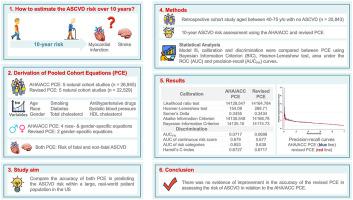Atherosclerosis ( IF 5.3 ) Pub Date : 2021-08-21 , DOI: 10.1016/j.atherosclerosis.2021.08.034 Alessandra M Campos-Staffico 1 , David Cordwin 1 , Venkatesh L Murthy 2 , Michael P Dorsch 1 , Jasmine A Luzum 1

|
Background and aims
Multivariable algorithms have been developed to predict the risk of atherosclerotic cardiovascular disease (ASCVD) to identify high-risk patients. Shortly after the introduction of the AHA/ACC Pooled Cohort Equations (PCE), a systematic overestimation of risk was identified. As such, a revised PCE was proposed to more accurately assess ASCVD risk. This study aims to compare the accuracy of both PCE in predicting ASCVD risk within a large, real-world patient sample in the US.
Methods
This retrospective cohort study identified 20,843 patients aged between 40 and 75 years with no previous ASCVD in an academic healthcare system. Model fit, calibration, and discrimination were compared between PCE using Bayesian Information Criterion (BIC), Hosmer-Lemeshow test, area under the ROC curves (AUC), Brier score, and precision-recall analysis. In addition, we examined race and sex subgroups for effect modification.
Results
Both PCE showed poor calibration (Hosmer-Lemeshow χ2 > 20; p < 0.05) and discrimination (AUC<0.7). The lack of improvement in discrimination of the revised PCE (AUC: 0.677 vs 0.679; p = 0.357) was confirmed with the AUC precision-recall curves (AUCPR: 0.0717 vs 0.0698). In contrast, the AHA/ACC PCE showed a strong positive risk prediction (ΔBIC>10) compared to the revised PCE, although calibration curves had overlapped.
Conclusions
In this single center analysis, both PCE had poor calibration and discrimination of ASCVD risk in a large, real-world patient sample followed up for over 2 years. There was no evidence of improvement in the accuracy of the revised PCE in assessing the risk of ASCVD in relation to the AHA/ACC PCE.
中文翻译:

预测动脉粥样硬化性心血管疾病的两个汇总队列方程的比较性能
背景和目标
已经开发了多变量算法来预测动脉粥样硬化性心血管疾病 (ASCVD) 的风险,以识别高危患者。在引入 AHA/ACC 合并队列方程 (PCE) 后不久,就发现系统性地高估了风险。因此,提议修订 PCE 以更准确地评估 ASCVD 风险。本研究旨在比较两种 PCE 在美国大型真实患者样本中预测 ASCVD 风险的准确性。
方法
这项回顾性队列研究在学术医疗保健系统中确定了 20,843 名年龄在 40 至 75 岁之间且既往无 ASCVD 的患者。使用贝叶斯信息准则 (BIC)、Hosmer-Lemeshow 检验、ROC 曲线下面积 (AUC)、Brier 评分和精确召回分析比较了 PCE 之间的模型拟合、校准和区分。此外,我们检查了种族和性别亚组的效果修正。
结果
两种 PCE 均显示出较差的校准 (Hosmer-Lemeshow χ 2 > 20; p < 0.05) 和辨别力 (AUC<0.7)。 AUC 精确召回曲线(AUC PR:0.0717对0.0698)证实了修订后的 PCE(AUC:0.677对0.679;p = 0.357)的辨别力没有改善。相比之下,与修订后的 PCE 相比,AHA/ACC PCE 显示出强烈的正风险预测 (ΔBIC>10),尽管校准曲线已经重叠。
结论
在这项单中心分析中,在随访超过 2 年的大型真实患者样本中,PCE 对 ASCVD 风险的校准和辨别能力都很差。没有证据表明修订后的 PCE 在评估与 AHA/ACC PCE 相关的 ASCVD 风险方面的准确性有所提高。



























 京公网安备 11010802027423号
京公网安备 11010802027423号